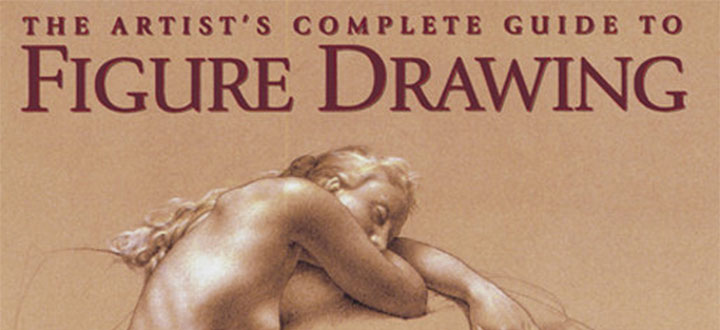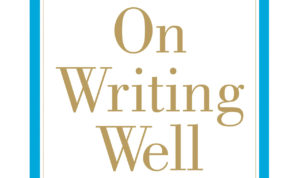The Artist’s Complete Guide to Figure Drawing: A Contemporary Perspective on the Classical Tradition, by Anthony Ryder. New York: Watson-Guptill, 1999. 160 pp. $24.99 (paperback).
In the Fall 2014 issue of The Objective Standard, I said (and did my best to show) that The Dictionary of Human Form by Ted Seth Jacobs was “one of the greatest books on art instruction ever written.” However, given that the book costs more than $150 and has more than eight hundred pages of detailed instruction, aspiring artists may find the book too daunting as an introductory text. For anyone wanting a less costly and more accessible book on drawing, I recommend The Artist’s Complete Guide to Figure Drawing: A Contemporary Perspective on the Classical Tradition by Anthony Ryder.
To begin with, Ryder is a superb artist. His figure drawings highlight the nobility of the human form and the beautiful subtleties of its structure. They capture with reverence important details such as the light that washes over a figure, and they portray not just a conceptualized figure but a unique and animated individual.
Ryder does not, as some do, wait for inspiration to strike and then work in an impassioned blitz. On the contrary, he produces a figure drawing in “about twelve three hour sessions” and works “at an even tempo,” as if he is “building a piece of furniture, carefully crafting, shaping, and polishing each part” (p. 12). He can do this to great effect because he has a deep understanding of the human form and the action of light, as well as a step-by-step process for translating both onto paper. This is what he shares in The Artist’s Complete Guide to Figure Drawing.
Everything a beginner needs to know is in this book, right down to the natures of different kinds of paper and the effects of different kinds of pencils on them. Ryder notes exactly which pencils produce which effects and where he would use one instead of another. He highlights basic practices essential to the art, such as remaining mentally present while drawing. He prepares beginners for the mistakes they will make as an inevitable part of the learning process. And he employs illuminating analogies to convey what is required to advance one’s skills. For example, Ryder writes:
Learning to use a pencil is like learning to use a fork. If you could remember how long it took, when you were a child, to learn to do things that required coordination, like eating spaghetti or peas, you might have more patience with yourself when it comes to learning how to use a pencil. (p. 20)
Ryder’s approach differs from that found in many other art instruction books. He does not recommend using shapes, such as eggs, cylinders, and cones, as building blocks of the figure. “Our interest is to develop a drawing with character: the specific, undiluted character of the model. So we avoid the use of character-negating elements” (p. 38). He offers no preset formula for parts of the figure. “We don’t expect the figure to be so many heads high, nor the head so many eyes wide” (p. 32). Instead, he says, “We rely on careful observation” (p. 32).
Ryder breaks down the process of observing the model into two basic skills, and he shows how to practice and thereby improve them. The first skill is “point-to-point measurement,” which “is the ability to measure the distance between any two points on the model and then check it against your drawing.” It involves repeatedly asking about any two points, “How long did it take me to get from here to there?” and comparing back and forth until “an underlying proportional regularity begins to reign in your drawing” (p. 32).
The second skill is that of measuring “the tilt of the lines.” After all, “It does you little good to know the distance between two points if you don’t also know the tilt of the lines connecting them” (p. 37). Here, Ryder recommends drawing a circle on the paper with different directions marked on it (like a compass), recording on it the tilt of a line on the model, and then comparing that with the corresponding line in the drawing. “Are the tilts of the two lines the same? If not, adjust the line . . . until it has the correct tilt” (p. 37).
Such practices are not merely for learning to draw; they are for drawing. They are for novices and professionals alike. “This isn’t a ‘been there, done that’ drawing method,” says Ryder. “It’s more like a ‘went there, stayed there, did that, still doing that’ kind of thing” (p. 37). He explains the importance of these skills and how to develop them with great care, detailing how he employs them in his own drawings.
But Ryder’s goal is not just to teach aspiring artists how to draw lines and tilts with accuracy. Above all, he wants to teach them to understand exactly what they see when they look at a figure. His teaching here echoes that of Ted Seth Jacobs, with whom Ryder studied for many years. But Ryder’s style and emphasis are his own, and the space he can devote to the qualities of human form and its interaction with light are, by comparison, substantially limited.
For example, where Jacobs has room in The Dictionary of Human Form and Light for the Artist to dive deep into the details of both, Ryder regularly condenses vast amounts of material into a few short paragraphs. Like this:
All the forms of the body are convex, meaning they are outwardly rounded. No part of the surface of the body is flat or concave (inwardly rounded). This is the principle of fullness. No matter how slender the model may be, the surface of his or her body is entirely composed of convex, “full” forms.
Fullness expresses presence in space. Full forms appear to have mass, weight, and substance. They are ample and communicate a feeling of plentitude. The form of the body has volume, burgeoning out from within. Fullness is expressed in the contour through convex curves, and on the inside, through the use of tonal progressions that give the appearance of rounded forms. . . .
The full forms of the body are not simply round. Their outwardly rounded surfaces also have tautness, like the surface of a sail. The squishy substance of the body is contained in a spandex-like tendon suit. This suit attenuates the “blobbiness” of the form, pulling it taut. Thus we are not really globular (thank goodness). In fact, if drawings are too full, they are referred to as “roundy.” A drawing without adequate fullness, on the other hand, can look kind of scrawny. As I said, the form of even a very slender model is full. If a contour lacks fullness, it is usually not so much a reflection of the model as it is of the artist’s lack of understanding of the fullness of the form. (p. 74)
Such eloquent and illustrative condensations are no easy feat, and they are a key value of the book.
Ryder conveys the process of seeing and drawing via step-by-step instruction, and he discusses how to think about the process while engaging in it. For example, in concluding the chapter on understanding form, Ryder writes:
The human figure is a living sculptor of the most sublime kind. It occupies space in a fascinatingly beautiful way. As you examine and evaluate form in your drawing, always think about how it turns, how its structures foreshorten, how its aspects change depending on its rotation in space, and how it projects within the virtual three-dimensional reality of the drawing. Give the form mass by developing its quality of fullness. Make these masses appear to turn (to have a particular degree of rotation in space) by situating their features correctly. Differentiate the masses by elaborating a network of pathways that wraps around them. And then refine this differentiation by chiseling into their surface to create many individual forms.
Finally, pay attention to your scale of observation. Forms of many different sizes coexist peacefully in the figure. Depending on your scale of observation, you may see only the tiny little forms, such as the separate forms that compose the eyelid, or perhaps only the great big ones, like a single mass of the hips and thighs. Large underlying forms convey the monumental nobility, while lesser forms suggest the anatomical mechanics, and the smallest forms express the elaborate and intricate structure of the surface of the body. If, in the course of drawing the figure, you integrate these different scales of observation, your drawing will develop a dynamic structural integrity, and the form of the body will take on a beautiful, naturalistic quality. (p. 122)
All of that is, of course, easier said than done. But so is the practice of any skill at a high level. Each requires understanding the basic principles of the field and how to apply them with respect to the complexities of a given situation.
Many people assume that the ability to artfully render the human figure is a skill beyond their reach. Ryder puts this false assumption to rest in the most effective way possible: by showing how to look and see and think and draw—using simple, learnable techniques that Ryder spells out in plain English and illustrates in plain sight. But learning these techniques is just the beginning. Applying them again and again is the goal. And, given that goal, The Artist’s Complete Guide to Figure Drawing is a field manual for making your world a more beautiful place.















